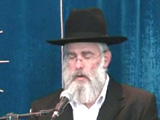Beit Midrash
- Sections
- Chemdat Yamim
- P'ninat Mishpat
Ruling: Last time we saw that the question of removing the he’az is on the assumption that def2 deserves to be paid.

P'ninat Mishpat (802)
Beit Din Eretz Hemda - Gazit
605 - Preserving the Management Company’s Security – part I
606 - Preserving the Management Company’s Security – part II
607 - Promotion that Didn’t Fully Happen
Load More
Beit din analyzed several passages in the partnership agreement. It mentions the need to pay third parties and that he’az is a means to ensure the payment of obligations, but no passage clearly says that a he’az should be used for a third party’s benefit and be put in his name. Everything is compatible with, although not explicit in support of, pl’s claim that the idea was to protect the group from individuals’ refusals to take part in paying third parties, as it would put the burden on remaining members. For that reason, the he’az was supposed to be in the name of def1, their lawyer.
There are several indications that the he’az was not intended as a security for def2. Def1 wrote a letter to pl explaining that he was forced to put the he’az in def2’s name because the Land Registry did not allow him to put it in his own name. He explained that it would not grant power to def2 because of the power of attorney def2 gave him to undo it. One of the financial institutions also referred to the arrangement in that way. Finally, if it were for def2’s benefit, it would have been mentioned in the management agreement (which focuses on def2’s rights).
A plaintiff can petition beit din to take steps to ensure there will be a means of his extracting payment from the defendant. However, beit din should do a "ma’azan nochot" to see which side’s needs are more pressing. In this case, all members of pl are responsible, if needed beyond their portion of ownership, to pay any award def2 might receive, and each owns property that can be used for this. Therefore, the danger to def2 of non-payment is negligible, and the claim that the he’az impedes pl’s ability to receive crucial financing is credible. Therefore, def2 must remove the he’az.

P'ninat Mishpat: Problematic Lights?
based on appeal of ruling 84085 of the Eretz Hemdah-Gazit Rabbinical Courts
Beit Din Eretz Hemda - Gazit | Cheshvan 5786

P'ninat Mishpat: Smoking Rights in a Rental? – part I
based on ruling 85076 of the Eretz Hemdah-Gazit Rabbinical Courts
Beit Din Eretz Hemda - Gazit | Tishrei 5786

P'ninat Mishpat: End of Tenure of Development Company – part I
based on ruling 77097 of the Eretz Hemdah-Gazit Rabbinical Courts
Beit Din Eretz Hemda - Gazit | Tammuz 5785

P'ninat Mishpat: Damage from Renovations
based on ruling 82093 of the Eretz Hemdah-Gazit Rabbinical Courts
Beit Din Eretz Hemda - Gazit | Elul 5785

Beit Din Eretz Hemda - Gazit

Who Breached the Contract? – part IV
Based on ruling 81087 of the Eretz Hemdah-Gazit Rabbinical Courts
Iyar 20 5783

A Commercial Rental for a Closed Business – part II
based on ruling 80047 of the Eretz Hemdah-Gazit Rabbinical Courts
Shvat 1 5782

Repercussions of a Sale That Turned Out Not Happening – part II
(based on ruling 83045 of the Eretz Hemdah-Gazit Rabbinical Courts)
18 Sivan 5784





















